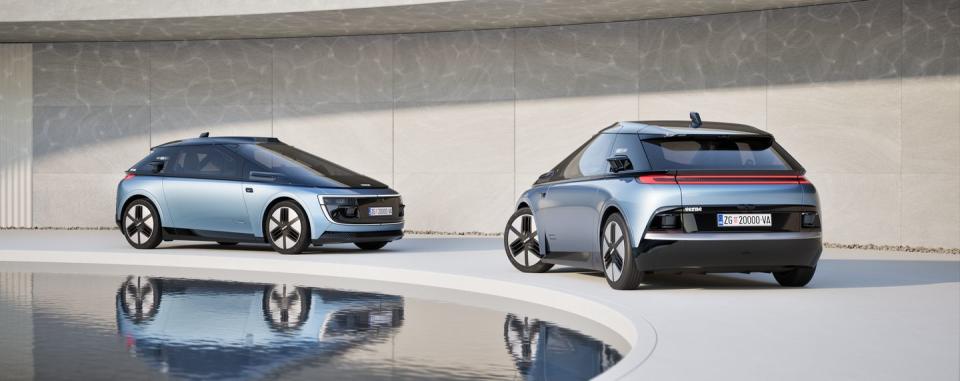Hypercar Maker Rimac Reveals the Fully Autonomous Verne Robotaxi

Rimac, the electric-hypercar maker that merged with Bugatti in 2021, has a new autonomous driving venture called Verne.
Verne's vehicle is a fully autonomous pod with seating for two that uses self-driving tech from Mobileye.
The first Verne robotaxi service is set to launch in Zagreb, Croatia, in 2026 before spreading throughout Europe and the Middle East.
Croatian startup Rimac rose to prominence over the past decade with electric hypercars like the 1813-horsepower Nevera and a high-profile merger with hypercar connoisseurs Bugatti in 2021. But now Rimac is expanding into a new realm with the Verne robotaxi, an autonomous pod that eliminates all driving controls and is due to hit the streets in 2026.
The company's name is a reference to Jules Verne, the 19th-century French writer famous for sci-fi adventure novels such as Journey to the Center of the Earth and Twenty Thousand Leagues Under the Sea. In a press release, the automaker cited Verne's focus on travel and the future in his stories as key inspirations for the company's autonomous vision.
Pushing Design Boundaries
The Verne robotaxi sports a very unorthodox look, smoothly styled with an unusual trapezoidal profile that is accentuated by a long windshield that nearly reaches the front of the vehicle. Verne says the odd shape is the result of designing from the inside out. Cameras and sensors poke out at various points, most notably the periscope protruding from the roof and sensors peeking out from the side windows, hinting at the vehicle's autonomous capabilities. Since the Verne vehicle is fully autonomous, the company was able to scrap features from human-driven cars like sideview mirrors and windshield wipers to create a more aerodynamic silhouette.

Riding on a new purpose-built platform, the Verne has been designed from the outset for autonomous driving. The self-driving system comes via a partnership with Mobileye, an Israeli company which is majority owned by Intel and one of the leaders in the autonomous-driving space. The robotaxi utilizes the Mobileye Drive autonomous architecture, comprised of a set of cameras, radar, and lidar sensors. Verne says the system is designed to work on a variety of road types, in different weather conditions, and can even take local driving styles into account.
A Room on Wheels
Unlike many other futuristic visions for self-driving pods, the Verne seats just two passengers. Verne says its data revealed that nine out of 10 rides are for just one or two people, so this layout lets them satisfy most customers while creating a capacious cabin in a compact footprint. Without mentioning a specific model, Verne claims it has more interior room than a Rolls-Royce.

The doors slide open to avoid disrupting traffic flow, and the opening is large enough for occupants to step in and sit down in a graceful manner. In typical fashion for an autonomous vehicle, Verne says it designed the cabin to be "less automotive and more like a living room." You won't find any driving controls inside, with the dashboard replaced by a 43-inch screen that can display entertainment or information about the trip. There is also a 17-speaker sound system and the "extra-large" seats have "five different levels of comfort," although Verne didn't specify what this means.
A touchscreen between the seats allows the rider to adjust the vehicle's settings. It also includes the "Median," a physical switch used to start and stop the ride, which Verne says is designed to give the user a sense of control. A rounded sunroof sits above, which Verne calls the "Halo ring."

The Verne Ecosystem
The vehicle isn't the only component of Verne. The company is also creating its own ride-hailing app. Customers will be able to adjust the vehicle's settings—from lighting to temperature and even scent—to their liking through the app before their ride arrives.
Each city that Verne operates in will feature a specialized infrastructure that the company calls the "Mothership," where the vehicles will be inspected, cleaned, maintained, and recharged each day. The first Mothership will be in Zagreb, next to Verne's headquarters.
Verne is currently constructing its first production facility in Croatia and aims to launch its first robotaxi service in Croatia's capital, Zagreb, in 2026. After that, the company plans to launch the vehicle worldwide, first to other European cities in the United Kingdom and Germany before expanding to the Middle East. Verne says it has signed agreements with 11 cities in the European Union, United Kingdom, and Middle East, and it's in discussions with more than 30 cities globally.
You Might Also Like

 Yahoo Finance
Yahoo Finance 